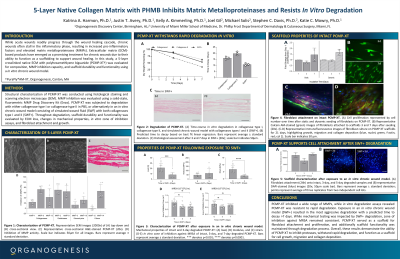Laboratory Research
(LR-009) 5-Layer Native Collagen Matrix with PHMB Inhibits Matrix Metalloproteinases and Resists In Vitro Degradation

While acute wounds readily progress through the wound healing cascade, chronic wounds often stall in the inflammatory phase, resulting in increased pro-inflammatory factors and elevated matrix metalloproteinases (MMPs). Biofilms, a major contributor to this stall in the inflammatory phase, are known to be present in 78.2% of chronic wounds1. In this study, we evaluated composition and MMP inhibition capacity of a 5-layer crosslinked native collagen extracellular matrix (ECM) with polyhexamethylene biguanide (PHMB; PCMP-XTº). Additionally, using an in vitro simulated wound fluid (SWF) model, we evaluated durability of graft structure and inhibition of Methicillin-resistant Staphylococcus Aureus (MRSA).
Methods:
Structural characterization of PCMP-XT was conducted using histological staining and scanning electron microscopy. MMP inhibition was evaluated using a solid-state, fluorometric MMP Drug Discovery Kit (Enzo). Degradation was assessed using a SWF model with or without the addition of collagenases type I and II. Throughout degradation, durability was measured by ECM loss and in vitro zone of inhibition studies.
Results:
PCMP-XT inhibited a wide range of MMPs including collagenases, gelatinases, and stromelysins. When evaluating ECM degradation in vitro, PCMP-XT was resistant to robust degradation by collagenases type I and II alone, resulting in 98.3% and 99.0% tissue remaining, respectively. SWF with collagenase type I and II increased in vitro degradation, resulting in 35.0% tissue remaining after 7 days; these results were confirmed with histological images. After 5 days of exposure in SWF plus collagenase types I and II, PCMP-XT zone of inhibition against MRSA remained consistent with no significant changes from day 0.
Discussion:
These results demonstrate the ability of a 5-layer crosslinked native collagen matrix with PHMB to inhibit MMPs, along with its durability in an in vitro simulated wound model, as measured by the mass loss and persistence of ZOI.
Trademarked Items: ºPuraply® AM-XT, Organogenesis, Canton, MA
References: 1. Malone M, Bjarnsholt T, McBain AJ, et al. The prevalence of biofilms in chronic wounds: a systematic review and meta-analysis of published data. J Wound Care. 2017;26(1):20-25. doi:10.12968/jowc.2017.26.1.20

.png)